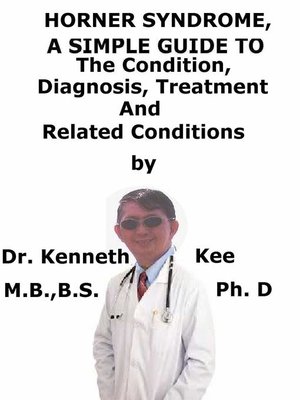Horner Syndrome, a Simple Guide to the Condition, Diagnosis, Treatment and Related Conditions
ebook
By Kenneth Kee

Sign up to save your library
With an OverDrive account, you can save your favorite libraries for at-a-glance information about availability. Find out more about OverDrive accounts.
Find this title in Libby, the library reading app by OverDrive.



Search for a digital library with this title
Title found at these libraries:
| Library Name | Distance |
|---|---|
| Loading... |
Horner syndrome also is the assortment of symptoms caused by a disruption of a nerve pathway from the brain to the face and eye on one side of the body.Horner syndrome can be induced by any interruption in a set of nerve fibers that begin in the part of the brain called the hypothalamus and travel to the face and eyes.These nerve fibers are involved with sweating, the pupils in the eyes, and some muscles around the eyes.Injury of the nerve fibers can result from:1. Injury to the carotid artery, one of the main arteries to the brain2. Injury to nerves at the base of the neck called the brachial plexus3. Migraine or cluster headaches4. Stroke, tumor, or other damage to a part of the brain called the brainstem5. Tumor in the top of the lung6. Injections or surgery done to interrupt the nerve fibers and relieve pain (sympathectomy)In rare cases, Horner syndrome is present at birth.The disorder may happen with a lack of color (pigmentation) of the iris (colored part of the eye).Horner syndrome is a result of injury to a certain pathway in the sympathetic nervous system.The sympathetic nervous system controls heart rate, perspiration, blood pressure, pupil dilation and other reactions typical to alterations in the environment.The nerve pathway that is injured due to Horner syndrome can be divided into 3 groups of nerve cells (neurons):First-order neuronsFirst-order sympathetic fibers begin in the hypothalamus and go down through the brainstem to level C8-T2 of the spinal cord where they synapse on pre-ganglionic sympathetic nerve fibers.1. Stroke2.Tumor (Pituitary or basal skull tumors)3.Neck trauma (e.g., cervical vertebral dislocation)4.Cyst or cavity in the spinal column (syringomyelia)Second-order neuronsThe second-order neurons spread from the spinal column across the upper chest and into the side of the neck1.Apical lung tumors (e.g., Pancoast tumor)2.Tumor of the myelin sheath (schwannoma)3.Damage to the aorta (Aneurysms of the aorta)4.Traumatic injuryThird-order neuronsThe third area of the nerve pathway spreads along the side of the neck leading to the facial skin and muscles of the iris and eyelids.1.Damage to the carotid artery and jugular vein (located along side of the neck)2.Tumor or infection near the base of the skull3.Migraines4.Cluster headachesA rare congenital form of Horner's syndrome is presentSymptoms of Horner syndrome may be:1. Reduced sweating on the affected side of the face2. Drooping eyelid (ptosis)3. Sinking of the eyeball into the face4. Small (constricted) pupil (the black part in the center of the eye)An eye examination may show:1.Changes in how the pupil opens or closesConstricted pupil on the affected side, more apparent in a darkened room:a.Shine a torch in the eye to make the pupil constrict.b.Remove the torch and watch the pupil dilate.c.Do the same on the other side and compare the response.2.Pupillary abnormalities3.Eyelid drooping4.Change in color of eyeSigns1.Ipsilateral dry skin on the face because of loss of sweating:a.Take both index fingers and place then together in the middle of the forehead.b.Then run them laterally over the forehead to just lateral to the eyebrows.On the affected side there may be more friction because the skin is drier as there is no sweating on that side.2.Examine for lymphadenopathyTestsChest x-ray or CT scanMRI or CT scan of the brainCT angiographyPharmacological testing with cocaine eyedropsA first- or second-order nerve lesion will lead to dilation but no dilation happens with third-order (postganglionic) lesionsTreatmentThe treatment depends on the cause of the problem.There is no treatment for Horner syndromeTABLE OF CONTENTIntroductionChapter 1 Horner SyndromeChapter 2 CausesChapter 3 SymptomsChapter 4...







